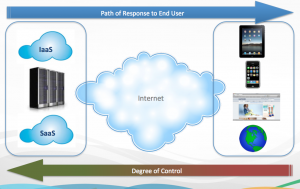By Lelah Manz
Special to the eTail Blog
Flash sale sites face the challenge of peak traffic every single day. As such, they present a great case study of how retailers can make the Internet work under unique pressures.
As content leaves your datacenter, your degree of control wanes
To understand and control the risks of the Internet, we need to evaluate the full path of content from the source, across the Internet, and on to the client. In today’s increasingly complex environment, that source of content can be a retailer’s datacenter cloud based infrastructure or SaaS/3rd party based content. The client side is equally complex, encompassing multiple devices and geographies, through interfaces either you or your partners control. 
Datacenter Scale
At the content’s source, the most critical component is scale. Several high profile sale event failures have taught us valuable lessons on how to prepare for best case traffic scenarios. Kevin Diamond, CTO of flash sale site Hautelook, has identified the critical factors to scaling for peak events as:
1. Know your threshold, and constantly reevaluate with growth
2. Identify bottlenecks at scale through comprehensive load testing
3. Virtualize your environment across a public or private cloud, relying on an effective load balancing strategy
4. Deliver as much content as possible from a content delivery service
5. Design pages to personalize content client-side, retrieving just the personalized elements via javascript, resulting in the entire page being cacheable
Internet Performance, Reliability, and Security
Personalized content like checkout processes shift the focus from scale to performance, reliability, and security. While the Internet may seem simple on the outside, it is actually a complex web of networks connected via peering points that are often based on business contracts versus performance. The lowest cost route of transit may be the most congested, resulting in loss of data and impacting performance.
These problems are compounded in mobile networks. Designed with voice rather than data in mind, mobile websites have page load speeds that average 9 seconds, putting them 11 years behind the desktop in terms of performance.
The complexity of the Internet has increased over the last 18 months with the growing threat of malicious attacks that can render sites unavailable for real buyers, or worse, put sensitive customer data at risk of theft. Fortunately these problems have largely been solved.
Client Complexity – Many Devices, Growing Destinations
We’ve talked a lot in the last year about the growing complexity of serving content to multiple devices with varying characteristics. Coupled with the need to serve geographic specific content, understanding where your user is and what device they are holding, usually dictates different content. A comprehensive strategy to capture and use that intelligence, and serve the right content with the first request, is key to improving bounce rates and engagement.
The Prescription for “Cloud Control”
As more content moves to the cloud, implementing a “cloud control” layer to consistently ensure near infinite scale, best-in-class performance reliability, and security, is critical.
Lelah Manz is the Chief Strategist of ECommerce at Akamai, a platform provider that helps businesses boost their digital presence by connecting the hyper-connected.




Recent Comments